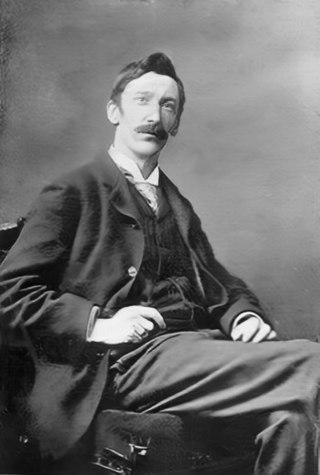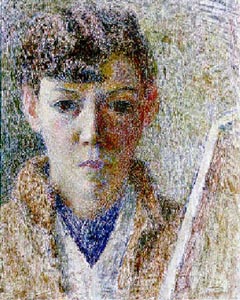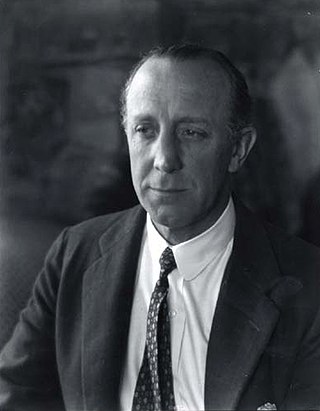
Benjamin Lauder Nicholson, OM was an English painter of abstract compositions, landscapes, and still-life. He was one of the leading promoters of abstract art in England.

Alfred Wallis was a British fisherman and artist known for his port landscapes and shipping scenes painted in a naïve style. Having no artistic training, he began painting at the age of 70, using household paint on scraps of cardboard. He achieved little commercial success, although his work was championed by progressive artists such as Ben Nicholson and Christopher Wood.

Stanhope Alexander Forbes was a British artist and a founding member of the influential Newlyn school of painters. He was often called 'the father of the Newlyn School'.
George Peter Lanyon was a British painter of landscapes leaning heavily towards abstraction. Lanyon was one of the most important artists to emerge in post-war Britain. Despite his early death at the age of forty-six he achieved a body of work that is amongst the most original and important reappraisals of modernism in painting to be found anywhere. Combining abstract values with radical ideas about landscape and the figure, Lanyon navigated a course from Constructivism through Abstract Expressionism to a style close to Pop. He also made constructions, pottery and collage.

The Royal West of England Academy (RWA) is Bristol's oldest art gallery, located in Clifton, Bristol, near the junction of Queens Road and Whiteladies Road. Situated in a Grade II* listed building, it hosts five galleries and an exhibition programme that celebrates the best of historic and contemporary British art.

William Scott was a prominent abstract painter from Northern Ireland, known for his themes of still life, landscape and female nudes. He is the most internationally celebrated of 20th-century Ulster painters. His early life was the subject of the film Every Picture Tells a Story, made by his son James Scott.
Jonathan Holt Titcomb was an English clergyman and the first Anglican bishop of Rangoon.
Bernard Dunstan was a British artist, teacher, and author, best known for his studies of figures in interiors and landscapes. At the time of his death, he was the longest serving Royal Academician.

Thomas Millie Dow was a Scottish artist and member of the Glasgow Boys school. He was a member of The Royal Scottish Society of Painters in Watercolour and the New English Art Club.

Algernon Mayow Talmage was a British Impressionist painter.

The St Ives School refers to a group of artists living and working in the Cornish town of St Ives. The term is often used to refer to the 20th century groups which sprung up after the First World War around such artists as Borlase Smart, however there was considerable artistic activity there from the late 19th Century onwards.

Dod Procter, born Doris Margaret Shaw, (1890–1972) was an English artist, and the wife of the artist Ernest Procter. Her painting Morning was bought for the public by the Daily Mail in 1927.
Paul Ludwig Horst Feiler was a German-born artist who was a prominent member of the St Ives School of art: he has pictures hanging in major art galleries across the world.

Paul Hampden Dougherty was an American marine painter. Dougherty was recognized for his American Impressionism paintings of the coasts of Maine and Cornwall in the years after the turn of the 20th century. His work has been described as bold and masculine, and he was best known for his many paintings of breakers crashing against rocky coasts and mountain landscapes. Dougherty also painted still lifes, created prints and sculpted.

Arnold Wathen Robinson RWA, FMGP (1888–1955) was an English stained-glass artist. Although Robinson's family, on the paternal and maternal side were involved in local government, he sought a career as a stained-glass artist. During World War I he initially enlisted in the Artists Rifles, and was then released from military service to manage a shell factory. Three of his four younger brothers were to be killed in the Great War.
Annie Walke or Anne Fearon Walke was an English artist. Anne Fearon grew up and was schooled in Banstead, Surrey. After completing her studies at the Chelsea School of Art and the London School of Art, she and her sister, Hilda Fearon, furthered their studies in Dresden, Germany. About the turn of the 20th century Miss Fearon settled in Cornwall, where she continued her studies and established a studio in the Cornish coastal village of Polruan. After she married Nicolo Bernard Walke in 1911, she soon moved with him to St Hilary, Cornwall. where her husband became the vicar in 1913. She was a member of the Newlyn School and other artists' organizations and created portraits and religious works for churches. Her work has been exhibited in England, Paris, America and South Africa. In the latter part of her life Walke was a published poet.
Harry Fidler (1856–1935) was a British painter known for including farm animals and especially horses in his impressionistic paintings, typically using heavy impasto. He married Laura Clunas, who was an artist with a similar style.
Sax Impey is a British artist. He currently lives and works in St Ives, Cornwall, England, occupying a Porthmeor studio and continuing in the tradition of Patrick Heron, Ben Nicholson, and other recognized artists.
Robert Borlase Smart RBA ROI RBC RWA SMA, generally known as Borlase Smart worked as an art editor and critic on the Western Morning News / Illustrated Western Weekly News from 1901 to 1913, but is principally known as an artist, in which capacity he became a founding member of the St Ives School during the years following his return from the First World War.











